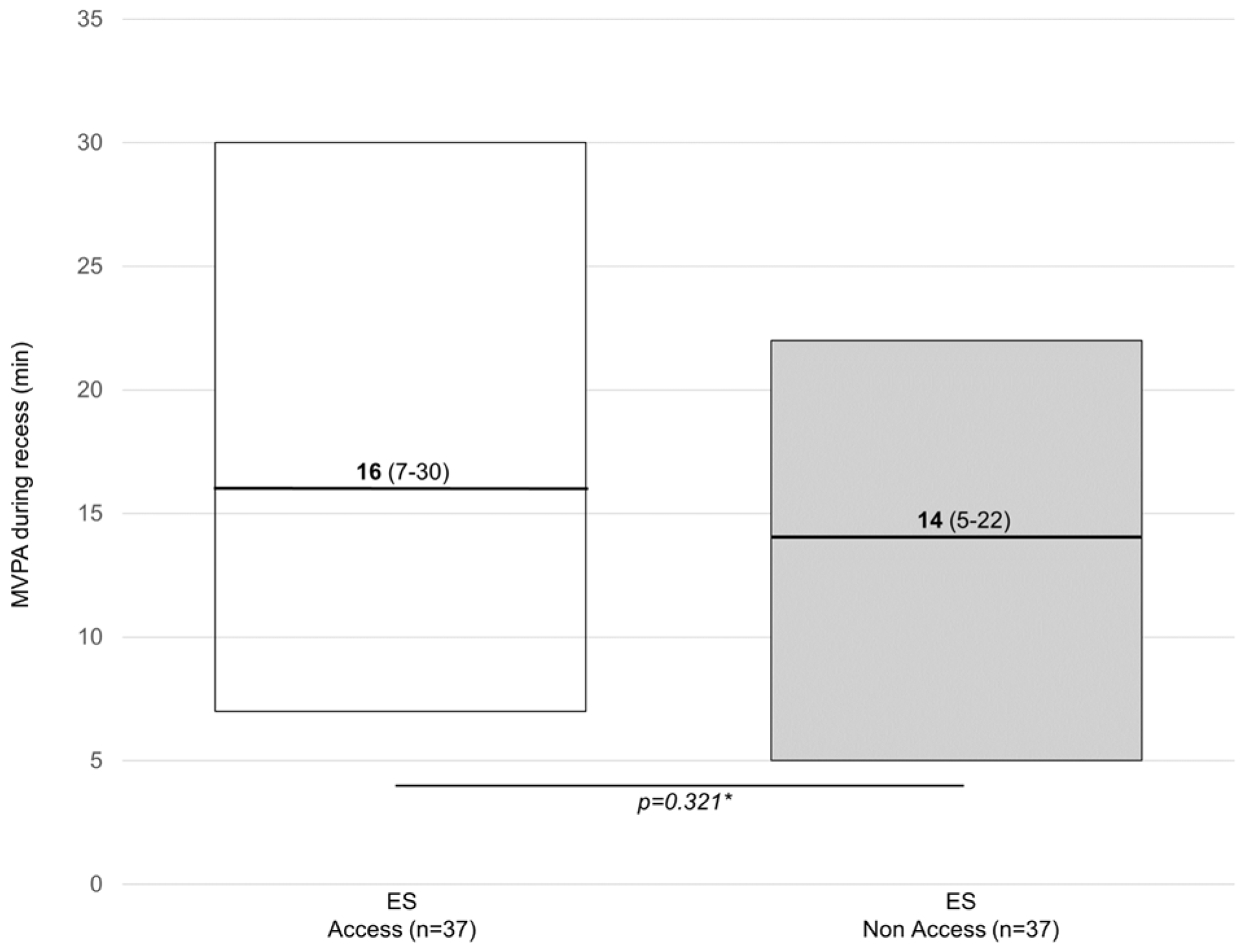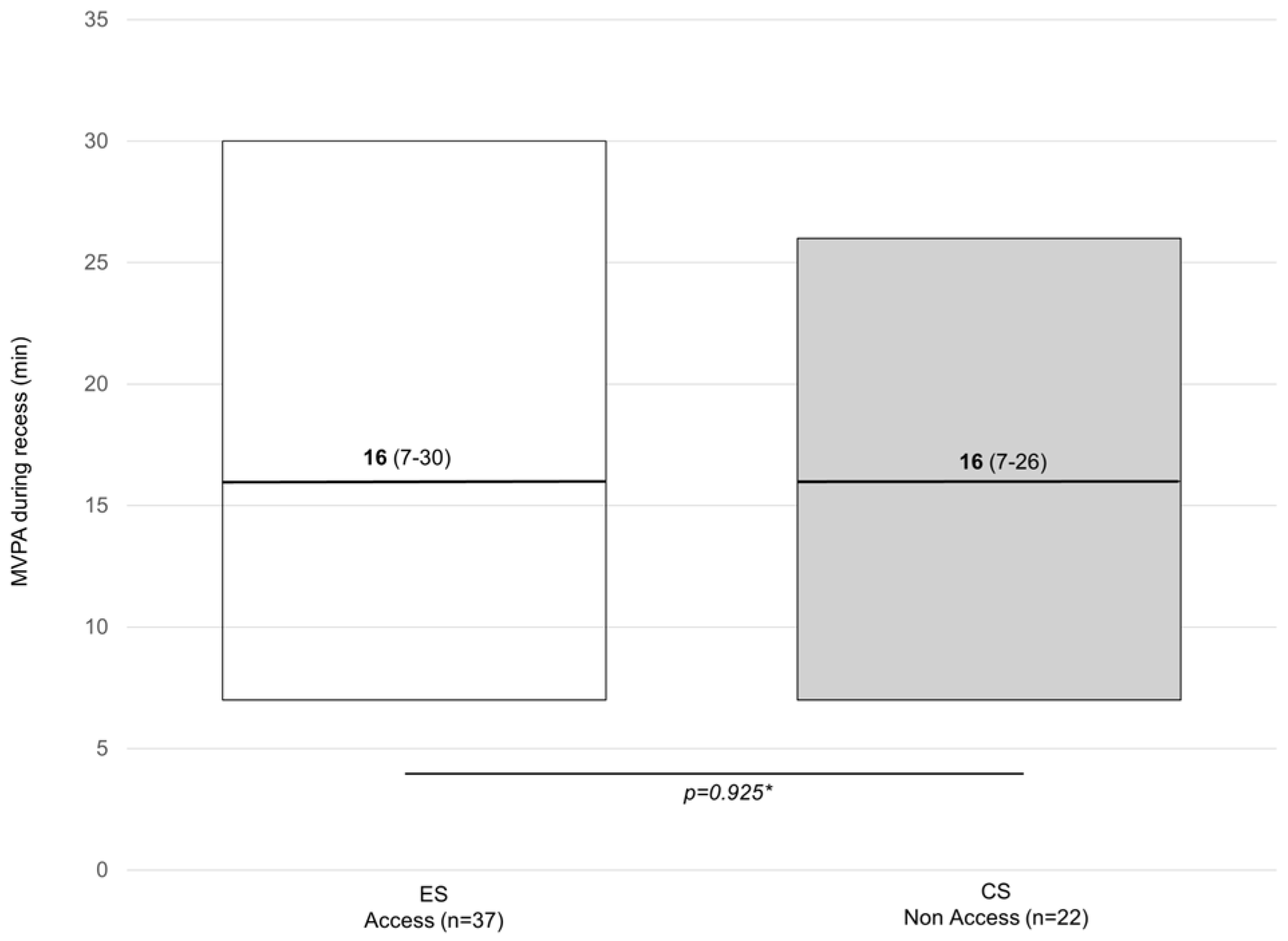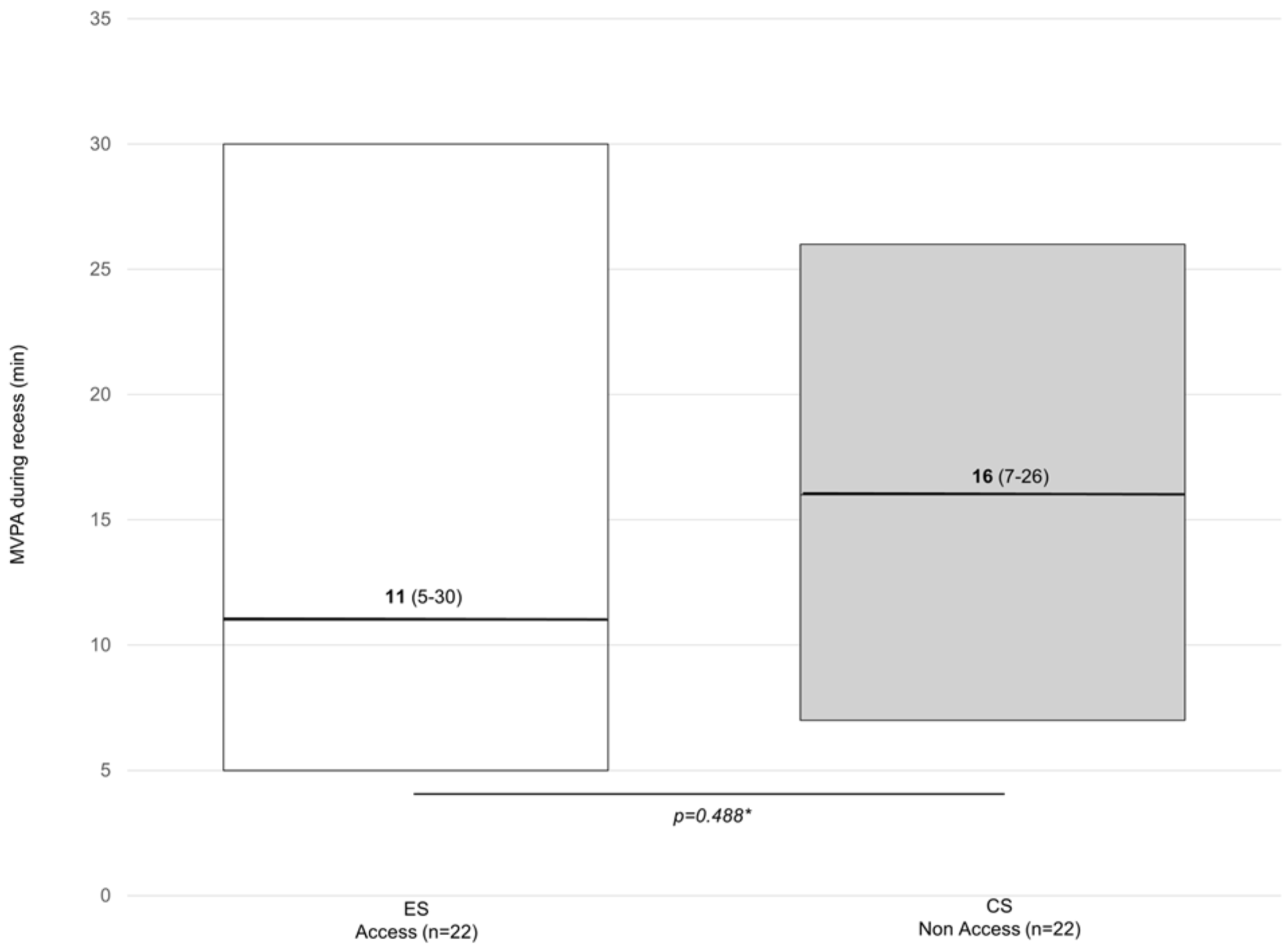Impact of Outdoor Play Structures on Moderate to Vigorous Physical Activity in Children during Recess: A Comparative Study
Abstract
1. Introduction
2. Materials and Methods
2.1. Setting and Participants
2.2. Moderate to Vigorous Physical Activity
2.3. Weather Conditions
2.4. Dimension of Play Space
2.5. Data Analysis
3. Results
4. Discussion
Author Contributions
Funding
Institutional Review Board Statement
Informed Consent Statement
Data Availability Statement
Acknowledgments
Conflicts of Interest
Appendix A
References
- Tremblay, M.S.; Carson, V.; Chaput, J.P.; Connor Gorber, S.; Dinh, T.; Duggan, M.; Faulkner, G.; Gray, C.E.; Gruber, R.; Janson, K.; et al. Canadian Society for Exercise Physiology 24-Hour Movement Guidelines for Children and Youth. Appl. Physiol. Nutr. Metab. 2016, 41, S311–S327. [Google Scholar] [CrossRef] [PubMed]
- Aubert, S.; Barnes, J.D.; Demchenko, I.; Hawthorne, M.; Abdeta, C.; Abi Nader, P.; Adsuar Sala, J.C.; Aguilar-Farias, N.; Aznar, S.; Bakalár, P.; et al. Global Matrix 4.0 Physical Activity Report Card Grades for Children and Adolescents: Results and Analyses From 57 Countries. J. Phys. Act. Health 2022, 19, 700–728. [Google Scholar] [CrossRef] [PubMed]
- U.S. Department of Health and Human Services (Ed.) Physical Activity Guidelines for Americans, 2nd ed.; Department of Health and Human Services: Washington, DC, USA, 2018. [Google Scholar]
- Atkin, A.J.; Sharp, S.J.; Harrison, F.; Brage, S.; Van Sluijs, E.M.F. Seasonal Variation in Children’s Physical Activity and Sedentary Time. Med. Sci. Sports Exerc. 2016, 48, 449–456. [Google Scholar] [CrossRef] [PubMed]
- Button, B.L.G.; Shah, T.I.; Clark, A.F.; Wilk, P.; Gilliland, J.A. Examining Weather-Related Factors on Physical Activity Levels of Children from Rural Communities. Can. J. Public Health 2020, 112, 107–114. [Google Scholar] [CrossRef] [PubMed]
- ParticipACTION. The Role of the Family in the Physical Activity, Sedentary and Sleep Behaviours of Children and Youth. The 2020 ParticipACTION Report Card on Physical Activity for Children and Youth; ParticipACTION: Toronto, ON, Canada, 2020. [Google Scholar]
- Burriss, K.; Burriss, L. Outdoor Play and Learning: Policy and Practice. Int. J. Educ. Policy Leadersh. 2011, 6, 1–12. [Google Scholar] [CrossRef]
- Ramstetter, C.; McNamara, L.; London, R.; Baines, E.; Beresin, A.; Claassen, J.; Doyle, W.; Hyndman, B.; Jarret, O.; Massey, W.; et al. Make Students Have Time for Daily Recess 2022. Available online: www.globalrecessalliance.org/statement-on-recess-translatable/ (accessed on 6 July 2023).
- Bogantes, C.Á.; Víquez, G.V.; Tenorio, J.V. Determination of physical activity during school recesses: Combining measurements of physical activity and children’s perspectives. MHSalud Rev. Cienc. Del Mov. Hum. Salud 2018, 14, 36–48. [Google Scholar] [CrossRef]
- Tremblay, M.S.; Gray, C.; Babcock, S.; Barnes, J.; Bradstreet, C.C.; Carr, D.; Chabot, G.; Choquette, L.; Chorney, D.; Collyer, C.; et al. Position Statement on Active Outdoor Play. Int. J. Environ. Res. Public Health 2015, 12, 6475–6505. [Google Scholar] [CrossRef] [PubMed]
- Truelove, S.; Vanderloo, L.M.; Tucker, P. Defining and Measuring Active Play Among Young Children: A Systematic Review. J. Phys. Act. Health 2017, 14, 155–166. [Google Scholar] [CrossRef] [PubMed]
- Frost, M.C.; Kuo, E.S.; Harner, L.T.; Landau, K.R.; Baldassar, K. Increase in Physical Activity Sustained 1 Year After Playground Intervention. Am. J. Prev. Med. 2018, 54, S124–S129. [Google Scholar] [CrossRef]
- Mårtensson, F.; Boldemann, C.; Söderström, M.; Blennow, M.; Englund, J.-E.; Grahn, P. Outdoor Environmental Assessment of Attention Promoting Settings for Preschool Children. Health Place 2009, 15, 1149–1157. [Google Scholar] [CrossRef]
- Government of New Brunswick. Policy 406 Outdoor School Play Areas 2003; Government of New Brunswick: Fredericton, NB, Canada, 2003. [Google Scholar]
- Peterborough Public Health. Outdoor Playspaces for Children: An Evidence Review; Peterborough Public Health: Peterborough, ON, Canada, 2017. [Google Scholar]
- U.S. Consumer Product Safety Commission. U.S. Consumer Product Safety Commission’s Public Playground Safety 2015; U.S. Consumer Product Safety Commission: Bethesda, MD, USA, 2015. Available online: https://www.cpsc.gov/s3fs-public/325.pdf (accessed on 6 July 2024).
- Wood, C.; Gladwell, V.; Barton, J. A Repeated Measures Experiment of School Playing Environment to Increase Physical Activity and Enhance Self-Esteem in UK School Children. PLoS ONE 2014, 9, e108701. [Google Scholar] [CrossRef] [PubMed]
- Kunkels, Y.K.; van Roon, A.M.; Wichers, M.; Riese, H. Cross-Instrument Feasibility, Validity, and Reproducibility of Wireless Heart Rate Monitors: Novel Opportunities for Extended Daily Life Monitoring. Psychophysiology 2021, 58, e13898. [Google Scholar] [CrossRef] [PubMed]
- Amireault, S.; Godin, G. The Godin-Shephard Leisure-Time Physical Activity Questionnaire: Validity Evidence Supporting Its Use for Classifying Healthy Adults into Active and Insufficiently Active Categories. Percept. Mot. Skills 2015, 120, 604–622. [Google Scholar] [CrossRef] [PubMed]
- Feehan, L.M.; Geldman, J.; Sayre, E.C.; Park, C.; Ezzat, A.M.; Yoo, J.Y.; Hamilton, C.B.; Li, L.C. Accuracy of Fitbit Devices: Systematic Review and Narrative Syntheses of Quantitative Data. JMIR Mhealth Uhealth 2018, 6, e10527. [Google Scholar] [CrossRef] [PubMed]
- Spierer, D.K.; Rosen, Z.; Litman, L.L.; Fujii, K. Validation of Photoplethysmography as a Method to Detect Heart Rate during Rest and Exercise. J. Med. Eng. Technol. 2015, 39, 264–271. [Google Scholar] [CrossRef] [PubMed]
- Pelizzo, G.; Guddo, A.; Puglisi, A.; De Silvestri, A.; Comparato, C.; Valenza, M.; Bordonaro, E.; Calcaterra, V. Accuracy of a Wrist-Worn Heart Rate Sensing Device during Elective Pediatric Surgical Procedures. Children 2018, 5, 38. [Google Scholar] [CrossRef] [PubMed]
- Brazendale, K.; Decker, L.; Hunt, E.T.; Perry, M.W.; Brazendale, A.B.; Weaver, R.G.; Beets, M.W. Validity and Wearability of Consumer-Based Fitness Trackers in Free-Living Children. Int. J. Exerc. Sci. 2019, 12, 471. [Google Scholar]
- Chandler, J.L.; Brazendale, K.; Beets, M.W.; Mealing, B.A. Classification of Physical Activity Intensities Using a Wrist-Worn Accelerometer in 8-12-Year-Old Children. Pediatr. Obes. 2015, 11, 120–127. [Google Scholar] [CrossRef]
- Hui, S.S.; Chan, J.W. The Relationship between Heart Rate Reserve and Oxygen Uptake Reserve in Children and Adolescents. Res. Q. Exerc. Sport 2006, 77, 41–49. [Google Scholar] [CrossRef]
- Stratton, G. Children’s Heart Rates during Physical Education Lessons: A Review. Pediatr. Exerc. Sci. 1996, 8, 215–233. [Google Scholar] [CrossRef]
- Machado, F.A.; Denadai, B.S. Validity of Maximum Heart Rate Prediction Equations for Children and Adolescents. Arq. Bras. Cardiol. 2011, 97, 136–140. [Google Scholar] [CrossRef] [PubMed]
- Armstrong, B.; Beets, M.W.; Starrett, A.; Brazendale, K.; Turner-McGrievy, G.; Saelens, B.E.; Pate, R.R.; Youngstedt, S.D.; Maydeu-Olivares, A.; Weaver, R.G. Dynamics of Sleep, Sedentary Behavior, and Moderate-to-Vigorous Physical Activity on School versus Nonschool Days. Sleep 2020, 44, zsaa174. [Google Scholar] [CrossRef] [PubMed]
- Weaver, R.G.; Beets, M.W.; Perry, M.; Hunt, E.; Brazendale, K.; Decker, L.; Turner-McGrievy, G.; Pate, R.; Youngstedt, S.D.; Saelens, B.E.; et al. Changes in Children’s Sleep and Physical Activity during a 1-Week versus a 3-Week Break from School: A Natural Experiment. Sleep 2019, 42, zsy205. [Google Scholar] [CrossRef] [PubMed]
- Berg, S. Children’s Activity Levels in Different Playground Environments: An Observational Study in Four Canadian Preschools. Early Childhood Educ. J. 2015, 43, 281–287. [Google Scholar] [CrossRef]
- Ridgers, N.D.; Fairclough, S.J.; Stratton, G. Variables Associated with Children’s Physical Activity Levels during Recess: The A-CLASS Project. Int. J. Behav. Nutr. Phys. Act. 2010, 7, 74. [Google Scholar] [CrossRef] [PubMed]
- Pellegrini, A.D.; Smith, P.K. School Recess: Implications for Education and Development. Rev. Educ. Res. 1993, 63, 51–67. [Google Scholar] [CrossRef]
- Powell, E.; Woodfield, L.A.; Nevill, A.A. Children’s Physical Activity Levels during Primary School Break Times: A Quantitative and Qualitative Research Design. Eur. Phys. Educ. Rev. 2016, 22, 82–98. [Google Scholar] [CrossRef]
- Tuckel, P.; Milczarski, W.; Silverman, D. Injuries Caused by Falls From Playground Equipment in the United States. Clin. Pediatr. 2018, 57, 563–573. [Google Scholar] [CrossRef] [PubMed]
- Public Health Agency. Potential Lost, Potential for Change. The Cost of Injury in Canada 2021; Public Health Agency: Ottawa, ON, Canada, 2021; Available online: www.canada.ca/en/public-health/services/injury-prevention/cost-injury-canada.html (accessed on 6 July 2024).
- Graham, M.; Dixon, K.; Azevedo, L.B.; Wright, M.D.; Innerd, A. A Socio-Ecological Examination of the Primary School Playground: Primary School Pupil and Staff Perceived Barriers and Facilitators to a Physically Active Playground during Break and Lunch-Times. PLoS ONE 2022, 17, e0261812. [Google Scholar] [CrossRef]
- Toft Amholt, T.; Westerskov Dalgas, B.; Veitch, J.; Ntoumanis, N.; Fich Jespersen, J.; Schipperijn, J.; Pawlowski, C. Motivating Playgrounds: Understanding How School Playgrounds Support Autonomy, Competence, and Relatedness of Tweens. Int. J. Qual. Stud. Health Well-Being 2022, 17, 2096085. [Google Scholar] [CrossRef]
- Burkart, S.; Parker, H.; Weaver, R.G.; Beets, M.W.; Jones, A.; Adams, E.L.; Chaput, J.-P.; Armstrong, B. Impact of the COVID-19 Pandemic on Elementary Schoolers’ Physical Activity, Sleep, Screen Time and Diet: A Quasi-Experimental Interrupted Time Series Study. Pediatr. Obes. 2022, 17, e12846. [Google Scholar] [CrossRef] [PubMed]
- Yelizarova, O.; Stankevych, T.; Parats, A.; Polka, N.; Lynchak, O.; Diuba, N.; Hozak, S. The Effect of Two COVID-19 Lockdowns on Physical Activity of School-Age Children. Sports Med. Health Sci. 2022, 4, 119–126. [Google Scholar] [CrossRef] [PubMed]
- Ickes, M.J.; Erwin, H.; Beighle, A. Systematic Review of Recess Interventions to Increase Physical Activity. J. Phys. Act. Health 2013, 10, 910–926. [Google Scholar] [CrossRef] [PubMed]
- Martin, K.; Bremner, A.; Salmon, J.; Rosenberg, M.; Giles-Corti, B. School and Individual-Level Characteristics Are Associated with Children’s Moderate to Vigorous-Intensity Physical Activity during School Recess. Aust. N. Z. J. Public Health 2012, 36, 469–477. [Google Scholar] [CrossRef] [PubMed]
- Belanger, K.; Barnes, J.D.; Longmuir, P.E.; Anderson, K.D.; Bruner, B.; Copeland, J.L.; Gregg, M.J.; Hall, N.; Kolen, A.M.; Lane, K.N.; et al. The Relationship between Physical Literacy Scores and Adherence to Canadian Physical Activity and Sedentary Behaviour Guidelines. BMC Public Health 2018, 18, 1042. [Google Scholar] [CrossRef]
- Nayakarathna, R.; Patel, N.B.; Currie, C.; Faulkner, G.; Riazi, N.A.; Tremblay, M.S.; Trudeau, F.; Larouche, R. Correlates of Outdoor Time in Schoolchildren From Families Speaking Nonofficial Languages at Home: A Multisite Canadian Study. J. Phys. Act. Health 2022, 19, 828–836. [Google Scholar] [CrossRef]



| ES (n = 37) Nonaccess: Morning Access: Afternoon | CS (n = 22) Nonaccess: Both Times | |
|---|---|---|
| Children | ||
| Age (years) | 8 (8–9) | 8 (8–9) |
| Sex (male) | 17 (46) | 11 (50) |
| Registered sports (yes) | 24 (65) | 13 (59) |
| Parents | ||
| Age (years) | 40 (38–44) | 37 (33–39) |
| Sex (male) | 13 (31) | 5 (23) |
| Total household income (CAD ≥80,000) | 20 (54) | 14 (63) |
| Marital status (married) | 31 (86) | 22 (100) |
| Education (college or above) | 35 (94) | 14 (63) |
| Employment (full-time) | 32 (62) | 17 (77) |
| Leisure time score (≥24: active) * | 35 (15–48) | 37 (23–56) |
| Resistant training (times per week) | 0 (0–2) | 2 (0–4) |
| ES (n = 37) | CS (n = 22) | |
|---|---|---|
| Minutes of MVPA | ||
| Week (7 consecutive days) | 173 (104–266) | 171 (130–298) |
| Weekdays (Monday–Friday) | 120 (89–225) | 125 (100–247) |
| Weekend (Saturday–Sunday) | 17 (7–46) | 31 (21–53) |
| School time (5 school days) | 80 (50–132) | 81 (46–148) |
| Meeting aerobic guidelines (60 min/day) | 7 (19) | 4 (18) |
| Coefficient | 95% CI | p-Value | Model Statistics | |
|---|---|---|---|---|
| Children * | 20.92 | −37.45–79.31 | 0.47 | Pseudo R square = 0.18; MAE = 8.64 |
| Access to play structures (Yes) | −1.79 | −11.06–7.47 | 0.69 | |
| Age (years) | −1.95 | −9.04–5.15 | 0.58 | |
| Sex (male) | 7.96 | −0.71–16.63 | 0.07 | |
| Weekly MVPA without recess (minutes) | 0.06 | 0.04–0.09 | <0.001 | |
| Parent’s physical activity (score) | −0.01 | −0.21–0.18 | 0.85 |
Disclaimer/Publisher’s Note: The statements, opinions and data contained in all publications are solely those of the individual author(s) and contributor(s) and not of MDPI and/or the editor(s). MDPI and/or the editor(s) disclaim responsibility for any injury to people or property resulting from any ideas, methods, instructions or products referred to in the content. |
© 2024 by the authors. Licensee MDPI, Basel, Switzerland. This article is an open access article distributed under the terms and conditions of the Creative Commons Attribution (CC BY) license (https://creativecommons.org/licenses/by/4.0/).
Share and Cite
Fuentes Diaz, M.F.; Sénéchal, M.; Bouchard, D.R. Impact of Outdoor Play Structures on Moderate to Vigorous Physical Activity in Children during Recess: A Comparative Study. Children 2024, 11, 828. https://doi.org/10.3390/children11070828
Fuentes Diaz MF, Sénéchal M, Bouchard DR. Impact of Outdoor Play Structures on Moderate to Vigorous Physical Activity in Children during Recess: A Comparative Study. Children. 2024; 11(7):828. https://doi.org/10.3390/children11070828
Chicago/Turabian StyleFuentes Diaz, Maria Fernanda, Martin Sénéchal, and Danielle R. Bouchard. 2024. "Impact of Outdoor Play Structures on Moderate to Vigorous Physical Activity in Children during Recess: A Comparative Study" Children 11, no. 7: 828. https://doi.org/10.3390/children11070828
APA StyleFuentes Diaz, M. F., Sénéchal, M., & Bouchard, D. R. (2024). Impact of Outdoor Play Structures on Moderate to Vigorous Physical Activity in Children during Recess: A Comparative Study. Children, 11(7), 828. https://doi.org/10.3390/children11070828






